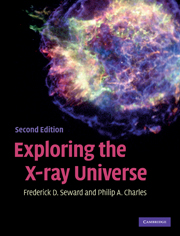Book contents
- Frontmatter
- Contents
- List of acronyms
- Foreword
- Chapter 1 Birth and childhood of X-ray astronomy
- Chapter 2 X-ray emission and interaction with matter
- Chapter 3 Tools and techniques
- Chapter 4 Solar system X-rays
- Chapter 5 X-ray absorption and scattering in the Interstellar Medium
- Chapter 6 Active stellar coronae
- Chapter 7 Early-type stars
- Chapter 8 Supernova explosions and their remnants
- Chapter 9 Neutron stars, pulsars, pulsar wind nebulae, and more supernova remnants
- Chapter 10 Cataclysmic variable stars
- Chapter 11 X-ray binaries
- Chapter 12 Black-hole X-ray binaries
- Chapter 13 Normal and starburst galaxies
- Chapter 14 Active galactic nuclei
- Chapter 15 Clusters of galaxies
- Chapter 16 The diffuse X-ray background
- Chapter 17 Gamma-ray bursts
- Index
- Plate section
Chapter 8 - Supernova explosions and their remnants
Published online by Cambridge University Press: 05 June 2012
- Frontmatter
- Contents
- List of acronyms
- Foreword
- Chapter 1 Birth and childhood of X-ray astronomy
- Chapter 2 X-ray emission and interaction with matter
- Chapter 3 Tools and techniques
- Chapter 4 Solar system X-rays
- Chapter 5 X-ray absorption and scattering in the Interstellar Medium
- Chapter 6 Active stellar coronae
- Chapter 7 Early-type stars
- Chapter 8 Supernova explosions and their remnants
- Chapter 9 Neutron stars, pulsars, pulsar wind nebulae, and more supernova remnants
- Chapter 10 Cataclysmic variable stars
- Chapter 11 X-ray binaries
- Chapter 12 Black-hole X-ray binaries
- Chapter 13 Normal and starburst galaxies
- Chapter 14 Active galactic nuclei
- Chapter 15 Clusters of galaxies
- Chapter 16 The diffuse X-ray background
- Chapter 17 Gamma-ray bursts
- Index
- Plate section
Summary
Introduction
This chapter describes phenomena caused by truly large explosions: catastrophic events in which large stars disintegrate completely. Vast clouds of stellar debris are ejected and are rapidly heated to temperatures of millions of degrees. This is a very important mechanism in astronomy, as it enriches the ISM with heavy elements, out of which new stars and planetary systems (such as our own) can be formed. These expanding clouds of hot gas are strong sources of X-ray and radio radiation. They shine clearly as extended objects with a great variety of shapes and are referred to as remnants of the supernovae.
Every few centuries there is a supernova close enough to be seen with the naked eye, and some of these have been spectacular. On 1 May 1006, a new star appeared in the constellation Lupus and, within a matter of days, became the brightest star observed in all of recorded history. According to records kept by Chinese and Arabic scholars at that time, this star seemed ‘glittering in aspect, and dazzling to the eyes’. ‘The sky was shining because of its light’. ‘Its form was like the half Moon, with Pointed rays shining so brightly that one could see things clearly’. This nearby supernova (a very bright ‘new star’) was awe inspiring. It was probably visible for 3 months during daylight, and only after 3 years did it fade below naked-eye visibility at night.
- Type
- Chapter
- Information
- Exploring the X-ray Universe , pp. 97 - 122Publisher: Cambridge University PressPrint publication year: 2010

